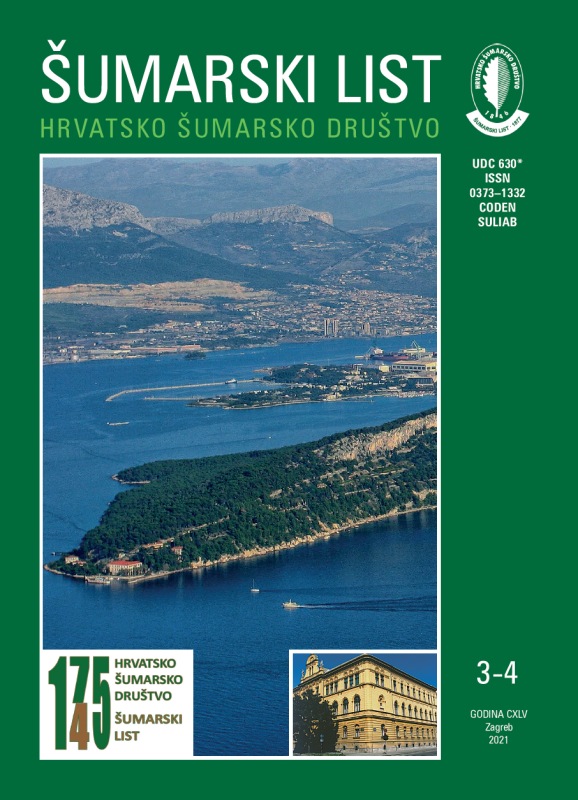
broj: 3-4/2021
pdf (11,5 MB) |
|
||||||||||||||
| RIJEČ UREDNIŠTVA | ||
| Uredništvo | ||
| Misunderstanding pdf HR EN | 113 | |
| IZVORNI ZNANSTVENI ČLANCI | ||
| Dino Hadžidervišagić, Azra Čabaravdić | UDK 630* 272 (001) https://doi.org/10.31298/sl.145.3-4.1 | |
| Importance and structural diversity of trees in a historical park pdf HR EN | 117 | |
| Dušan Jovanović, Milan Gavrilović, Mirko Borisov, Miro Govedarica | UDK 630*902 (001) https://doi.org/10.31298/sl.145.3-4.2 | |
| Deforestation monitoring with Sentinel 1 and Sentinel 2 images – the case study of Fruška gora (Serbia) pdf HR EN | 127 | |
| PRETHODNO PRIOPĆENJE | ||
| Boris Miklić, Anja Žmegač, Domagoj Trlin , Marko Orešković, Stjepan Mikac, Igor Anić | UDK 630* 111.8 https://doi.org/10.31298/sl.145.3-4.3 | |
| Climate sensitivity of black pine (Pinus nigra Arnold.) chronology in the Northern Velebit pdf HR EN | 137 | |
| Jelena Kranjec Orlović, Ida Bulovec, Milivoj Franjević, Damjan Franjević, Josip Skejo, Marin Biliškov, Danko Diminić, Boris Hrašovec | UDK 630*232.3 + 442 https://doi.org/10.31298/sl.145.3-4.4 | |
| Preliminary results on narrow-leaved ash (Fraxinus angustifolia Vahl) and green ash (Fraxinus pennsylvanica Marshall) seed entomofauna in Croatia pdf HR EN | 147 | |
| Summary Native narrow-leaved ash (Fraxinus angustifolia Vahl) and introduced green ash (F. pennsylvanica Marshall) are two most common ash (Fraxinus spp.) species in Croatian lowland forests, taking a significant place in these ecosystems. In the recent past it has been observed that narrow-leaved ash seed yields have reduced, emphasising the importance of good health status of those collected, as they are used for seedling production and consecutive regeneration of forest stands or afforestation. Given that insects could be an important factor affecting ash seed health status, the aim of this research was to gain insight into the species being present and their frequency in the ash seeds. In total 2.500 narrow-leaved ash and 1.000 green ash seeds from seven different locations were screened for insect presence. Analysed seeds were categorized as undamaged, insect damaged or empty, and observed insect specimens were identified by morphological and molecular genetic analysis. Green ash seeds revealed higher insect infestation in comparison with native ash species, with weevil Lygniodes bischoffii being the most numerous pest found. Narrow-leaved ash seeds were mostly occupied by the native weevil species, L. enucleator. Besides these pests, larval, pupal, and adult stages of parasitoid wasps (Hymenoptera) and larval stage of the seed eating moth Pseudargyrotoza conwagana (Lepidoptera) were found in both ash species. However, given that pests detected in this study prefer urban areas or were present in a very small number of seeds, where they were often followed by parasitoids, it can be concluded that insects currently do not have a significant negative impact on the reproduction of narrow-leaved ash and green ash in forest stands. Key words: ash; seed damage; weevils; Lygniodes; parasitoid wasps; Pseudargyrotoza conwagana | ||
| Mirjana Stevanov, Albina Tarjan Tobolka, Ljubomir Kljajić, Martina Kičić, Max Krott | UDK 630*903 https://doi.org/10.31298/sl.145.3-4.5 | |
| Analysis of conflicing interests on the example of the special nature reserve in Serbia: empirically analytical approach pdf HR EN | 155 | |
| Erol Akkuzu, Mustafa Şahin, Abdullah Ugiş, Ebru Bal | UDK 630* 453 https://doi.org/10.31298/sl.145.3-4.6 | |
| Assesment of trap color and trap height above the ground on the capture of Ips sexdentatus and Thanasimus formicarius pdf HR EN | 169 | |
| PREGLEDNI ČLANCI | ||
| Damir Barčić, Vlado Habjanec, Željko Španjol, Mario Šango | UDK 630* 111.5 + 421 https://doi.org/10.31298/sl.145.3-4.7 | |
| Analysis of raising windbreaks on the mediterranean karst of Croatia pdf HR EN | 175 | |


